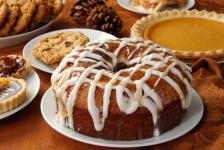How to Adjust Your Holiday Recipes
Learn easy tips to halve or double your recipes—plus other kitchen tricks.
Jason Marshall, PhD
Listen
How to Adjust Your Holiday Recipes

How to Halve or Double a Recipe
The basic math behind halving or doubling a recipe is exactly that…basic. There really are no surprises here: To halve a recipe, just use half as much of all the ingredients; and to double a recipe, just use twice as much of everything. For example, it’s no surprise that if a recipe calls for 1 cup of flower, a half-batch of this recipe includes 1/2 cup of flour, and a double-batch needs 2 cups. If a recipe is given in terms of weight instead of volume, just divide the weight in half or double it to find the weight required in the half or double batch. So if a recipe calls for 9 ounces of flour, a half-batch would use 4.5 ounces and a double-batch would use 18 ounces.
There’s one caveat to this rule (this is part of that “there’s more to it than you might think” I mentioned earlier). Although this may be a topic better suited for Nutrition Diva or your favorite cooking blog, I’ll note that a lot of people suggest taking extra care with seasonings and spices when halving recipes. In particular, if you’re halving a recipe, you probably want to start by using a bit less than half of the seasonings and spices called for. After all, it’s easy to add a bit more of something, but it’s really hard (meaning pretty much impossible) to subtract stuff once it’s already in there!
How to Increase or Decrease the Size of a Recipe
Of course, the world of recipe alterations isn’t always as simple as halving and doubling. Perhaps you’re making a recipe for 12 servings but you really only need 4 servings. What do you do? Well, one thing you could do is just make all 12 servings, eat 4, and save the other 8 to enjoy later. But if you already have plenty of leftovers, can barely get the refrigerator door shut, and really want to cut that—or any—recipe down to size, the Quick and Dirty Tip for doing so is to divide the amount of each ingredient by the total number of servings in the recipe and then to multiply these amounts by the actual number of servings you want to make. So, in this case, since you want 4 servings instead of the 12 servings that the recipe makes, you need to multiply the required weight or volume of all the ingredients by 4/12 or 1/3.
Why does this work? Well, when you divide by the number of servings, you’re really figuring out how much of each ingredient you need for a single serving of the recipe. And then when you multiply by the number of servings you want, you’re converting these amounts for a single serving into the amounts for the number of servings you actually want.
Handy Conversions for Doubling Recipes
As it turns out, when it comes to the ease with which you can cut measurements in half, not all are created equal. While it’s simple to cut something like 2 cups, 1 cup, or 1/2 cup in half, it’s not exactly a cinch to cut a measurement like 3/4 cup in half. After all, half of 3/4 cup is 3/8 cup…and I don’t know about you, but I don’t have a 3/8 cup measuring device in my kitchen arsenal! But as luck would have it, it turns out that 1/4 cup is also equal to 4 tablespoons (which is easy to remember since they both have a 4 in them) and, therefore, that 1/8 cup is equal to half as much or 2 tablespoons. Which means that since 3/8 = 2/8 + 1/8 = 1/4 + 1/8, we can easily measure out 3/8 cup simply by measuring out 1/4 cup plus 2 tablespoons.
In addition to this handy conversion, it’s also good to keep one other conversion in mind. Namely, that 1 tablespoon is equal to 3 teaspoons. Once you know this, it’s easy to figure out things like how to halve a recipe calling for 1/3 tablespoon of something. Since 1 tablespoon is 3 teaspoons, 1/3 tablespoon must be 1 teaspoon. And half of that is just 1/2 teaspoon.
Tip of the Week: How Do You Halve an Egg?
Before we finish up for today, it’s time for this week’s featured tip from my post on QDT’s blog The Quick and Dirty. This week’s tip is really more of a cooking tip than a math tip, but it’s extremely relevant to our discussion here since it will help you deal with a problem you’re sure to encounter when adjusting recipes. And that problem is the dreaded: What do I do when I’m halving a recipe that calls for 1 egg?
It’s not like you can cut an egg in half, right? Well, I guess you could first freeze an egg and then cut it in half. While that’s pretty clever, it’s not particularly practical (or safe). The easiest way to halve an egg is simply to crack the entire egg into a bowl, whisk the yolk and white together, and then measure out half of the combined egg by weight or volume.
Wrap Up
Okay, that’s all the math (and cooking) we have time for today. Remember to become a fan of the Math Dude on Facebook where you’ll find a new featured number or math puzzle posted every weekday. And if you’re on Twitter, please follow me there too. Finally, if you have math questions, feel free to send them my way via Facebook, Twitter, or by email at mathdude@quickanddirtytips.comcreate new email.
Until next time, this is Jason Marshall with The Math Dude’s Quick and Dirty Tips to Make Math Easier. Thanks for reading, math fans!

